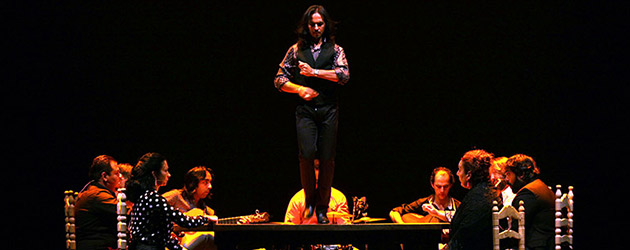Text: Estela Zatania
Photos: Antonio Acedo
18th Bienal de Flamenco de Sevilla
Monday, September 15th, 2014. 8:30pm. Teatro de la Maestranza
The classic contemporary timeless Flamenco of Farruquito
Dance: Farruquito (Juan Manuel Fernández Montoya). Cante: La Mari (Ana Vizárraga), La Fabi (Fabiola Pérez), Zambullo (José Manuel Doya), David de Jacoba (David Maldonado). Guitar: Román Vicenti, Carlos de Jacoba (Carlos Maldonado). Percussion: El Piraña (Israel Suárez). Flute: Juan Parrilla (Juan Fernández Gálvez). Violin: Thomas Potiron.
Monday evening at the Bienal de Flamenco de Sevilla, there was a full house at the Maestranza Theater for the debut of «Pinacendá», Farruquito's newest work.
The last time he appeared at the Bienal four years ago, the dancer followed the fashion of shows with a story-line, guest artists and music that was far-removed from flamenco, but it didn't work. The formula he has always used is the one that still serves him best. Classic flamenco dance in the family line of contained fury, impressive footwork and dramatic build-ups, all wrapped up with simple staging and supported by a fine assortment of flamenco singers and good solid guitars. Easier said than done. In fact, the extraordinary dancing of the star of the show is the essential ingredient that makes the machine run. This isn't the dancing of Farru, nor of Carpeta or Barullo, all excellent in a similar line. Farruquito has artistic maturity and a certain darkness, possibly the result of his direct contact with grandfather Farruco, that gives the dimension his brothers and cousin have not yet acquired.
«Pinacendá» in the Caló language means Andalusia. The word was also used years ago by guitarist Andrés Batista, who had a lot of contact with old Farruco, for the title of one of his bulerías compositions. It represents the dancer's desire to highlight the gypsy race, the region of Andalusia and in general, his take on flamenco. According to the program, the idea is to journey «through each one of the provinces of Andalusia», although there are 7 pieces to cover 8 provinces. Málaga is missing, but then there is a medley of abandolao that includes refereces to this province.
The voice of singer Fabiola at 7 or 8 «por medio» with all the associated brilliance, breaks the silence with siguiriyas. Three church windows are projected on the backdrop giving a feeling of profound reverence. Flamenco as religion, untouchable and worthy of maximum respect. This is diametrically opposed to the contemporary perspective such as had been presented by Israel Galván on Sunday. And you realize both paths are valid and necessary. In less than five minutes, as tends to happen with Farruquito's shows, the audience was already whipped up into a frenzy.
There is a sort of medley of fandangos de Huelva which is powerfully flamenco, mining cante, danced alegrías, some fine tangos de Granada and a bulerías marathon. But the most moving moment was the surprise appearance of Pilar la Faraona, daughter of old Farruco and aunt of Farruquito. Barefoot, and with a straw basket, her unexpected presence triggered a wave of nostalgia that only increased when she danced with her nephew.
At eleven o'clock at the Espacio Santa Clara, there was more flamenco for classic tastes with Miguel Funi and Inés Bacán in a show titled «En Estado Puro».
